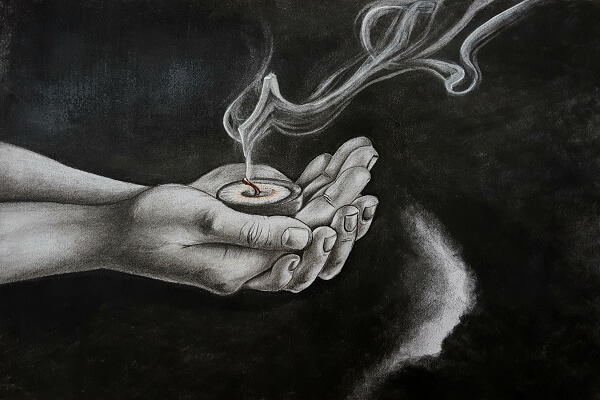Artists have been using charcoal for millennia. It is a highly expressive medium that may be used to make anything from fine lines to broad, dramatic brushstrokes. Charcoal artworks, from personal to memorial portraits, stand out from others because of their unique look and feel.
In addition, it has been around since prehistoric times, making it one of the earliest forms of artistic expression. It’s a fantastic medium to experiment with, whether you’re just starting or have years of experience. Discover this versatile media’s rich history and contemporary uses in this article.
Contents
The Evolution of Charcoal Use in Arts
Charcoal’s path from a simple medium used in cave paintings to one revered by contemporary artists worldwide is interesting. Charcoal has evolved to meet the needs of artists by providing them with new tools and ways to express themselves. It has been used for centuries to capture the essence of light, shadow, and texture in various mediums, from sketching and drawing to investigating portraits, landscapes, and abstraction.
Artists are pushing the frontiers of charcoal art today, experimenting with mixed media, accepting faults, and even using it as a form of meditation. This medium’s ageless charm stems from its capacity to elicit raw emotions, communicate depth and atmosphere, and serve as a canvas for classic and contemporary artistic expressions.
Charcoal Varieties and Their Applications
Charcoal comes in various forms, allowing artists to explore new approaches, textures, and tonal ranges. The following are examples:
Vine Charcoal
Vine charcoal, made from willow or grapevine, is soft, easily blendable. It’s great for quick sketches, freeform gestures, and loose, delicate linework.
Compressed Charcoal
Powdered charcoal is turned into compressed charcoal by being compressed into sticks or blocks. It comes in various hardnesses, from very soft to quite hard. The lines drawn with soft compressed charcoal are rich and dark, whereas those drawn with hard charcoal are finer and lighter. It’s a standard tool for artists to employ when drawing in fine detail, shading, and developing three-dimensional creations.
Charcoal Pencils
A charcoal pencil core distinguishes it from a standard graphite pencil. Compared to standard charcoal skewers, they provide greater precision and control. Artists often choose charcoal pencils because of their fine points, ability to draw precise lines, and versatility in creating varied textures.
Powdered Charcoal
Finely ground charcoal, often known as “powdered charcoal,” can be purchased in jars or on its own. It can be used to create large, dramatic strokes and for more subtle effects like dusting and smearing. Powdered charcoal is commonly used for surface toning, atmospheric effects, and large-scale drawings.
Willow Charcoal
As a softer alternative to vine charcoal, willow charcoal is crafted from slender willow branches. It’s ideal for blending and blurring because of the soft, velvety lines it draws. Drawing from life, creating portraits, and doing tonal studies are all frequent uses for willow charcoal.
Charcoal Sticks
One of the most common uses for charcoal is in the form of charcoal sticks. Different kinds of marks can be made with them because of their texture and the range of sizes available. Charcoal sticks can be used for various purposes, from sketching to shading to making expressive, powerful strokes.
Guidelines for Charcoal Novices
The most important aspect is to appreciate charcoal for what it is. Please don’t be scared to mess with your charcoal work; it’s all about experimentation and self-expression. Here are a few pointers to get you started:
Get the essentials first
Start with drawing paper, a sketchbook, and charcoal pencils and sticks. As your skills improve, you can branch out and try new charcoal and surfaces.
Try out a variety of techniques
Use charcoal’s adaptability by experimenting with various methods. Allow your imagination to run wild as you appreciate the possibilities of this expressive medium.
Adjust the amount of force applied
To get a range of values from bright to dark, apply different amounts of pressure to the charcoal. Try using light and strong strokes to learn the variety of values charcoal may produce. Check Feedce.com.
Don’t overuse adhesives
You will use fixatives to set the charcoal and stop the smudging. Only apply a thin, even layer of fixative when necessary.
Create rough drafts
Quick, basic sketches give a sense of the overall composition and form. There will be plenty of practice before the meat of the work begins.
Build up layers
In terms of value and layering, charcoal is a very forgiving medium. To add depth and complexity to your artwork, start with lighter layers and work to deeper tones.
Make use of blending tools
Try smudging and mixing the charcoal with tools like blending stumps, tortillons, or soft brushes to achieve seamless transitions and nuanced gradations.
Get Your First Charcoal Painting Commissioned
The charcoal painting celebrates its flaws, providing a raw, organic style that evokes authenticity and proximity. The way it captures light, shadow, and texture gives the spectator a one-of-a-kind visual experience. Learn how effective charcoal can be with the help of Memorialize Art. The website is a gateway to classic and evocative charcoal paintings, whether you’re looking for a portrait of yourself or a touching memorial tribute. Artists at Memorialized Art are masters in capturing their subjects’ personalities and emotions on canvas through the dramatic effects of charcoal. Although it has been around for a long time, charcoal is still a fascinating medium with much to offer regarding artistic expression.




